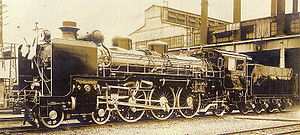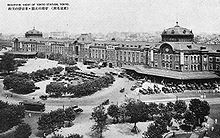- Japanese Government Railways
-
Japanese Government Railways 
C51 locomotive decorated to haul the imperial train, 1940Locale Japan, nationwide Dates of operation 1872–1949 Successor Japanese National Railways Track gauge 3 ft 6 in (1,067 mm) Length 18,400 km (1941) Headquarters Tokyo The Japanese Government Railways (JGR) was the national railway system directly operated by the central government of Japan until 1949. It is a predecessor of Japanese National Railways and the Japan Railways Group.
Contents
Name
The English name "Japanese Government Railways" was what the Ministry of Railways (鉄道省 Tetsudōshō) of Japan (established in 1920) used to call its own "Ministry Lines" (省線 shōsen) and sometimes the ministry itself as a railway operator. Other English names for the government railways include Imperial Japanese Government Railways and Imperial Government Railways, which were mainly used prior to the establishment of the ministry. This article however covers the railways operated by the central government of Japan from 1872 to 1949 notwithstanding the official English name of the system of each era.
Network
By the end of World War II in 1945, the Japanese Government Railways operated on the main Japanese islands of Honshū, Hokkaidō, Kyūshū, Shikoku and Karafuto. The railways in Taiwan and Korea were operated by the local Governor-General Offices and were not part of JGR.
Total operating distance of JGR as of March 31 of each year[1] Year Distance
mi km 1881 76.3131 122.8140 1891 551.22 887.10 1901 822.49 1,323.67 1906-07: railway nationalization 1911 4,870.6 7,838.5 1921 6,484.7 10,436.1 1931 9,056.4 14,574.9 1941 11,433.2 18,400.0 While the JGR was the only major operator of intercity railways after the railway nationalization in 1906-07, privately owned regional railways were also active.
The gauge of the railway was 1,067 mm (narrow gauge) with minor exceptions (184.2 km total in the peak years of 1936-38[2]) of 762 mm gauge lines.
History
The first railway in Japan was operated by the imperial government in 1872. The governmental system was largely expanded by the promulgation of the Railway Nationalization Act in 1906. In 1920, the Ministry of Railways was established.
In 1949, JGR was reorganized to become a state-owned public corporation named the Japanese National Railways.
Timeline
- June 12, 1872 - Provisional opening of Tokyo-Yokohama railway (Shinagawa Station - Yokohama Station)
- October 14, 1872 - Formal opening of Tokyo-Yokohama railway (ceremony at Shimbashi and Yokohama Stations)
- October 1, 1907 - Completion of nationalization of 17 private railways under 1906 Railway Nationalization Act
- December 20, 1914 - Opening of Tokyo Station
- November 1, 1925 - Inauguration of the Yamanote Loop Line
- April 1, 1943 - Inclusion of Karafuto prefectural lines into national system
- February 1, 1946 - Official exclusion of Soviet-occupied Karafuto lines from national system
- June 1, 1949 - Establishment of Japanese National Railways, i.e. end of Japanese Government Railways
- April 1, 1987 - Privatization of JNR, establishment of seven JR companies
Historical operators of JGR
Before the establishment of the Japanese National Railways as a public corporation on June 1, 1949, the Japanese Government Railways were operated by the governmental agencies. The table below shows the historical operators of the JGR.[3] Translated names of ministries may not be official. Names of the operating department generally mean "department (or office, section, agency) of railways" or like.
Date of
establishmentMinistry Department Note 1870-04-19 Civil and Finance Ministry (民部大蔵省 Minbu-Ōkura-shō) 鉄道掛 (Tetsudō-gakari) in charge of construction only 1870-08-06 Civil Ministry (民部省 Minbu-shō) 1870-12-12 Ministry of Industry (工部省 Kōbu-shō) 1871-09-28 鉄道寮 (Tetsudō-ryō) First railway opened in 1872. 1877-01-11 鉄道局 (Tetsudō-kyoku) 1885-12-22 Cabinet (内閣 Naikaku) 1890-09-06 Home Ministry (内務省 Naimu-shō) 鉄道庁 (Tetsudō-chō) 1892-07-21 Ministry of Communications (逓信省 Teishin-shō) 1893-11-10 鉄道局 (Tetsudō-kyoku) 1897-08-18 鉄道作業局 (Tetsudō-sagyō-kyoku) Tetsudō-kyoku survived as an administrative body for private railways till 1908. 1907-04-01 帝国鉄道庁 (Teikoku-Tetsudō-chō) 1908-12-05 Cabinet (内閣 Naikaku) 鉄道院 (Tetsudō-in) Government Railways were commonly called In-sen (院線). 1920-05-15 Ministry of Railways (鉄道省 Tetsudō-shō) Government Railways were commonly called Shō-sen (省線). 1943-11-01 Ministry of Transport and Communications (運輸通信省 Un'yu-Tsūshin-shō) 鉄道総局 (Tetsudō-sōkyoku) 1945-05-19 Ministry of Transport (運輸省 Un'yu-shō) Tourism promotion
One of the roles of the Japanese Government Railways was to attract foreign tourists to Japan. In 1930, the government created the Board of Tourist Industry (国際観光局 Kokusai Kankō Kyoku) as a section of the Japanese Government Railways (Ministry of Railways). The Board printed and distributed picture posters and English guidebooks overseas and encouraged development of resort hotels at home.[4] The Board was dissolved in 1942, following the breakout of the Pacific War in 1941.
Notable people
- Inoue Masaru - Head of the government railways between 1871 and 1893
- Hirai Seijirō - Head of the government railways between 1904 and 1908
- Gotō Shinpei - Head of the government railways between 1908 and 1911
- Takejirō Tokonami - Head of government railways in 1920s and early 1930s
- Eisaku Satō (Prime Minister of Japan in 1960s) - serves as a railway official between 1924 and 1948
Notes
- ^ Ishino, Tetsu et al. (eds.) (1998) (in Japanese). Teishajō Hensen Daijiten - Kokutetsu JR Hen. Tokyo: JTB Corporation. pp. 256-285, vol. I. ISBN 4533029809.
- ^ ja:国鉄の特殊狭軌線 (Japanese Wikipedia), retrieved on 2009-04-06
- ^ Ishino, supra, p. 42, vol. I
- ^ Nakagawa, Koichi (March 1998). "Prewar Tourism Promotion by Japanese Government Railways" (PDF). Japan Railway and Transport Review (East Japan Railway Culture Foundation): 25–27. Archived from the original on 2006-10-08. http://web.archive.org/web/20061008025135/http://www.jrtr.net/jrtr15/pdf/f22_nak.pdf. Retrieved 2007-11-14.
Categories:- Defunct railway companies of Japan
- Government of Japan
- Railway companies disestablished in 1949
Wikimedia Foundation. 2010.


